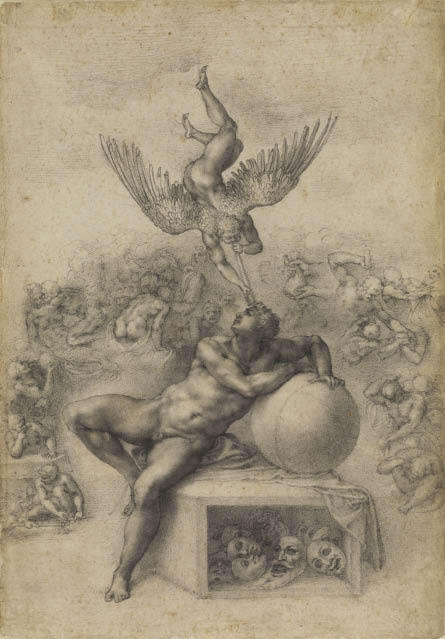Michelangelo’s Dream
Courtauld, until 16 May
This is one of the series of exhibitions built around a single masterpiece from the Courtauld’s collection — in this case Michelangelo’s remarkable presentation drawing ‘The Dream’ — placed in an informative context of closely related loans. The Courtauld does it superbly: quietly stated, rigorously researched, laid out with clarity and authority. It is accompanied by a hefty but handsome catalogue (published by Paul Holberton, £30 in paperback), packed with scholarly exegesis, with particularly useful notes on individual exhibits. The show consists of a group of Michelangelo drawings, original letters and poems by the artist, and certain works by his contemporaries.
I’m not entirely happy about the inclusion of autograph manuscripts in exhibitions of drawings and paintings. We can see it in two shows concurrently in London: van Gogh at the Academy and this one. Visitors are drawn to letters like iron filings to a magnet. Even if they can’t read the language of the cursive script, there will be a translation to hand, and they pore over such documents as if the written page will relinquish more secrets than a painting or drawing will ever be able to do. It just goes to show, once again, that the British are more at ease with the written word than the visual image, but this urge to limit themselves should not be encouraged — at least not in exhibitions of art. This kind of documentation should be kept for displays in libraries or reserved for illustration in the catalogue. Otherwise, I fear it distracts too much from the pictures.
The presentation drawings were highly finished objects made as artworks in their own right to be presented to someone special. Although we cannot be sure, ‘The Dream’ seems to have been given to the beautiful young Roman nobleman Tommaso de’ Cavalieri, with whom Michelangelo fell in love. (Tommaso was aged around 16 when they first met.) They remained friends for 30 years, and Cavalieri was present when the artist died. During that time, Michelangelo sent Tommaso many drawings, some of them allegories the meaning of which is clear, others more opaque. None is so elusive in its import as ‘The Dream’.
A lumpy-bottomed winged spirit approaches a sleeping, dreaming youth with a trumpet to awaken him from his foul imaginings. Traditionally, the figures surrounding the naked youth reclining against a globe have been interpreted as vices (gluttony, lust, avarice, and so forth). Meanwhile, the plinth he leans against contains a box of masks of very mixed identities. What does it all mean? The complexity of the allegory is indubitably part of its attraction, and was intended to provide hours of enjoyable discussion and speculation. It’s a lovely idea that a group of friends should sit around discussing a picture’s possible meaning, while offering intelligent appreciation and assessment of the drawing itself. I hope such debate still occurs, and not just in academic institutions.
The related drawings by Michelangelo include three versions of the Fall of Phaeton, in which the very sculptural central motif is the wonderful tangle of falling horses (each carefully individualised) from the sun god’s chariot. ‘Tityus’ (a giant in Hades punished by a vulture devouring his ever-renewing liver), ‘The Resurrection’ with its brilliant diagonal composition, and the exquisite red chalk drawings of Lazarus all repay close attention. The drawing of Ganymede, the pretty boy seized by Zeus in the form of an eagle to be his cupbearer and catamite, is another marvel. These drawings deserve more than my encomia, they deserve to be seen. Hasten forth, art lovers, though you might wish to avoid prolonged study of the children’s bacchanal in red chalk: tremendous artistry but something repellent about the subject.
The second room contains fabulous comparative work arranged under the theme of Virtues and Vices, Dream and Sleep, by the likes of Marcantonio Raimondi, Dürer, circle of Mantegna and Cristofano Robetta. Riveting stuff. The unsuspecting visitor may not realise that it is now necessary to traverse a room of impressive German Expressionist paintings (by artists of the calibre of Kandinsky, Jawlensky and Munter) to reach the second part of the Michelangelo exhibition, which is in fact a separate display, though fundamentally linked to the main show. Don’t let the Expressionist hiatus break your concentration, for there are still good things to be seen in this display, which is called ‘Looking at Michelangelo’.
Principally there is the beautiful late drawing by the master, ‘Christ on the Cross’, a thing of more spirituality than physicality, as the artist (now nearly 90) muses on death and the significance of the Crucifixion. There are two more drawings by him, a small study entitled ‘Aeneas and a Child’ and a much earlier and more vigorous pen and ink drawing, ‘Christ before Pilate’. There’s a marvellous Pontormo drawing, his famous study of a seated boy, and a horrible muscle-bound Tintoretto (the flesh like bubbling porridge), which is a study after Michelangelo’s ‘Evening’. I preferred the Baccolo Bandinelli ink drawing with its semi-Futurist echoes (did the Futurists really think they could sever all connection with the past?), and the big composite print of Michelangelo’s ‘Last Judgment’, jigsawed together from ten separate sheets of paper.
Will the hierarchical bias against drawings that we seem to suffer today extend even to the indisputable masterworks in this exhibition? It is emphatically to be hoped not, though those in search of a dramatic exhibition full of colour or storm and stress would do better to stay in the Expressionist room. This is a scholarly display, demanding close looking and a preparedness to do a little reading. It is a thoroughly rewarding show, but not in an immediate or obvious way. Properly art historical, it is however not just for academics, but is genuinely accessible to the interested amateur. A triumph of quality over sensationalism, and full of beauty.






Comments